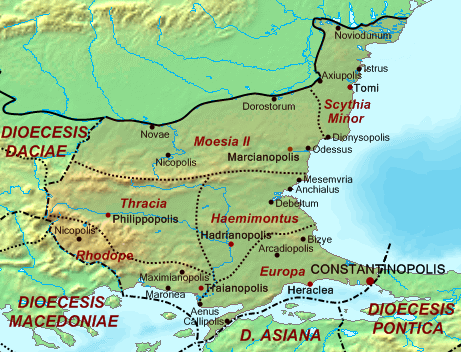Perperius
Veoma poznat
- Poruka
- 14.958
Може ли на овој теми да се убаци гласање по питању како звати ово полуострво на коме смо, где би понуђени одговори били рецимо: да остане Балкан, Мала Европа, Хелм или можда још нека опција.
Dinarsko poluostrvo ?
Donji video prikazuje kako da instalirate aplikaciju na početni ekran svog uređaja.
Napomena: This feature may not be available in some browsers.
Може ли на овој теми да се убаци гласање по питању како звати ово полуострво на коме смо, где би понуђени одговори били рецимо: да остане Балкан, Мала Европа, Хелм или можда још нека опција.

Imamo li podatak gde se sve pouzdano za Balkansko poluostrvo koristi naziv Helm ili Haemus ili Ajmos i sl; ko, gde i kada? Da to na jednom mestu bude izneto.

Imamo li podatak gde se sve pouzdano za Balkansko poluostrvo koristi naziv Helm ili Haemus ili Ajmos i sl; ko, gde i kada? Da to na jednom mestu bude izneto.
..кад је назив Haemus био у употреби,

Међу изразима типа "Хл''м тракијски назив прецизно одражава стање на терену, да се ради о ланцу планина, а не о једној планини.
А српски средњевековни израз "Хл'м" условно тачно одражава стање на терену, ако је оно Х- нешто што умножава (ланац), а Л'м је каменолом, дакле ланац ломова......... један дуууугачак и вееелики природни каменолом.
Овај Аутор, на два места, помиње Балкан и Стару планину упоредо, као два засебна појма.На другом месту, објашњава да је Стара планина само од Књажевца до реке Вид ....,а Балкан је преостали источни део планине




Листала сам сада војну студију из 1901. "Илирско тропоље", које поменух без линка за кљигу малопре, и нашла на два места нешто збуњујуће што можда мења целу ствар. Овај Аутор, на два места, помиње Балкан и Стару планину упоредо, као два засебна појма.

Na ovoj (vrlo autohtonističkoj) mapi koja se šeruje po fejsbuku ( i od koje se ograđujem, mene nervira kad vidim O ubačeno u ime Srba)
 ili po izradi bih rekao da nije ni fotošop koristio nego Paint.
ili po izradi bih rekao da nije ni fotošop koristio nego Paint.Mene nervira kada autohtonisti postave ovakvu mapu kao dokaz za nešto, a što se tiče ove konkretno mape više je nego očigledno da se ovde neko igrao fotošopaili po izradi bih rekao da nije ni fotošop koristio nego Paint.
Ubacio plavu boju (i gde treba i gde ne treba), izbrisao šta mu se ne sviđa i dodao tekst koji je on hteo i sve to na karti Evrope koja verovatno predstavlja rasprostranjenost četinara ili neke druge flore ili faune. Stvarno jadno.

Допринос француског географа Гијома де Лила тумачењу дела Константина Порфирогенита Старе карте су значајан извор у расветљавању недоумица око положаја првих насељених градова у покрштеној Србији. Највећи допринос на том пољу дао је Гијом де Лил (Guillaume Del-Isle, Париз, 1675-1726), француски "први географ краљевске Академије", састављач великог атласа који су под насловом "Atlas novеаu" издали у Амстердаму Ковенс и Мортје. Постао је члан "Académie Royale des Sciences" у 27. години, и касније је добио титулу "Premier Geographee du roi" ("први географ краљевине"). Његов највећи пројекат је "Atlas de Géographie", публикован 1774. године у Паризу и Амстердаму.

Из овог погрешног схватања о Централном Билу произашло је и садање име Балканског Полуострва. Источни његов део звао се Хемус. То име примењено на планине које нису много удаљене од Цариграда, и које су често помињали класични и византијски писци, било је познатије од оних, која су давата другим деловима Централног Била. Испитивачи у почетку XIX века сазнали су да се класични Хемус зове Балкан.
.. име планинског венца, које би се по праву могло применити само на један део Централног Била, погрешно се употребило и њиме је означен цео венац.

Тако и ја схватих ову проблематику


Александар Лома - Топонимија Бањске хрисовуље: ка осмишљењу старосрпског топономастичког речника и бољем познавању општесловенских именословних образаца, САНУ, Одељење језика и књижевности, Одбор за ономастику, Библиотека Ономатолошких прилога, књ. 2, Београд, 2013, 130.
Kakva je poruka?
A u skraćenoj varijanti "Helm"Гласајте:
1. Хелмско полуострво
2. Хемско полуострво
3. Хумско полуострво
4. Мала Европа (по узору на Малу Азију)
5. Хемус
6. Тропоље
Можете изабрати и више опција. Гласам за 1 (примарни назив), и 4 и 6 (синоними).
ДодатоA u skraćenoj varijanti "Helm"

